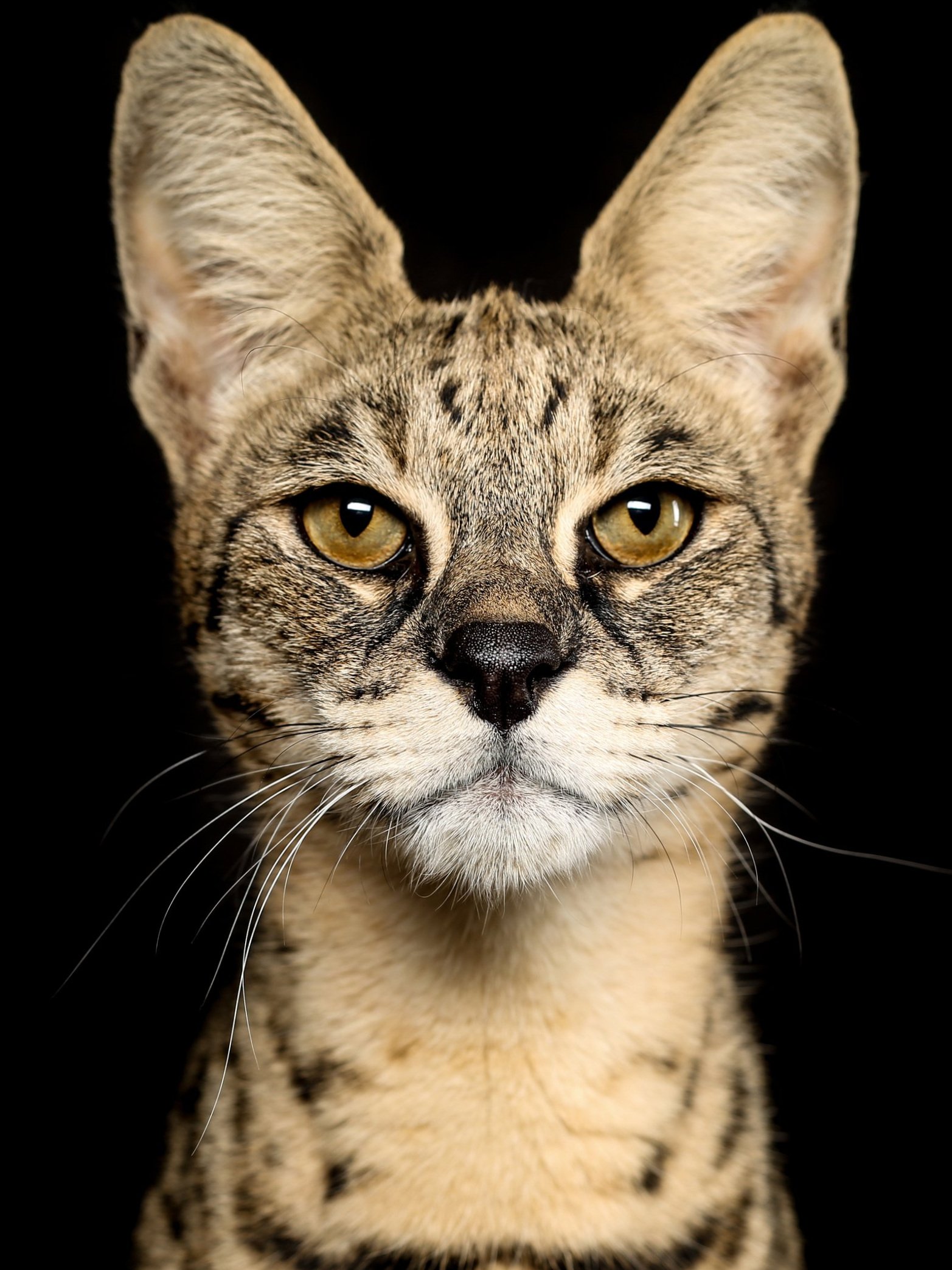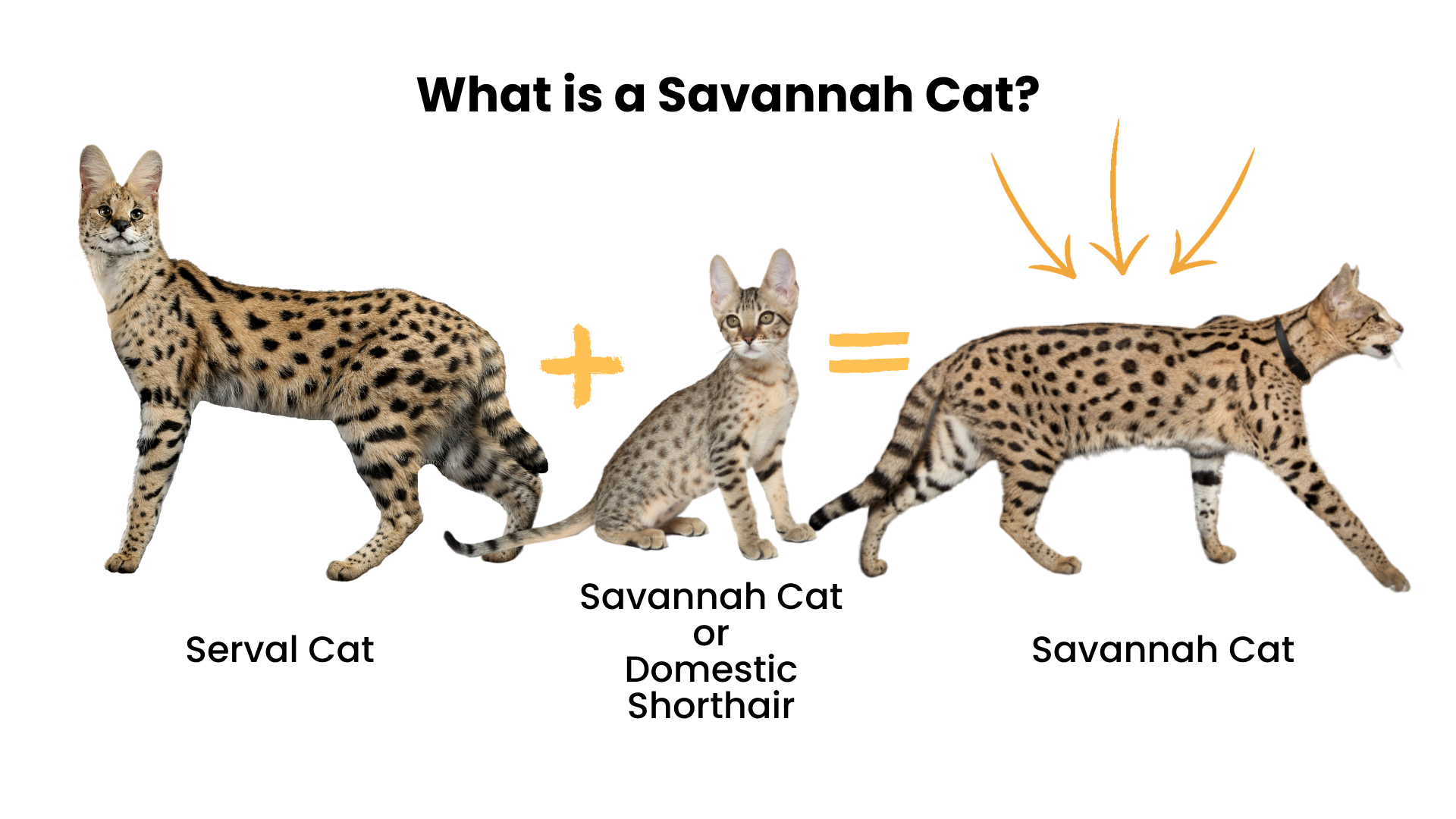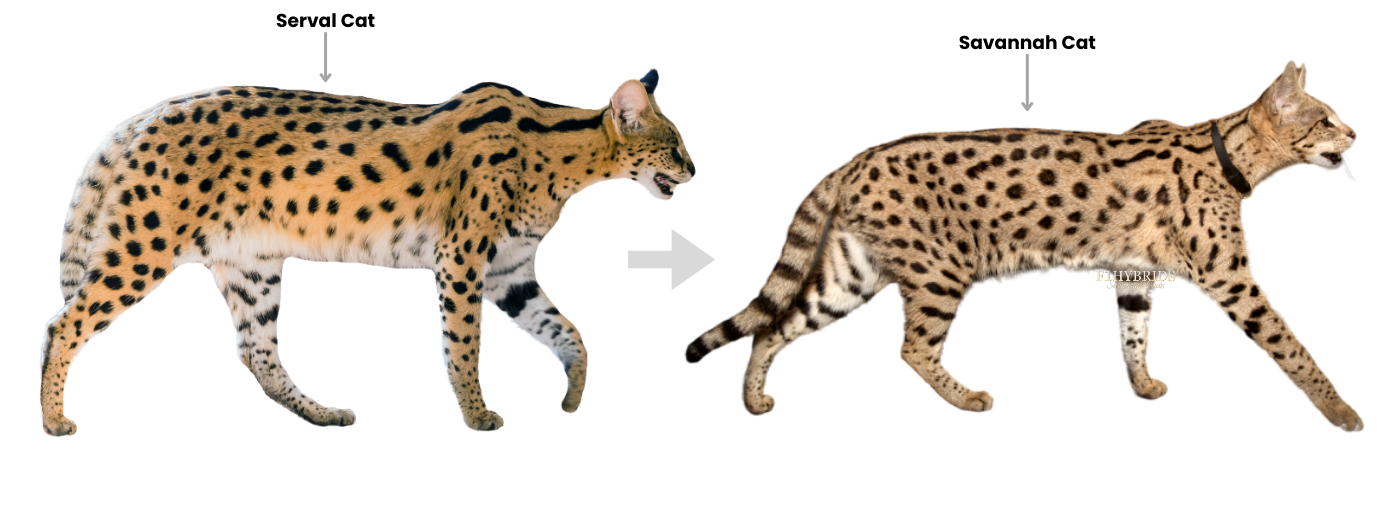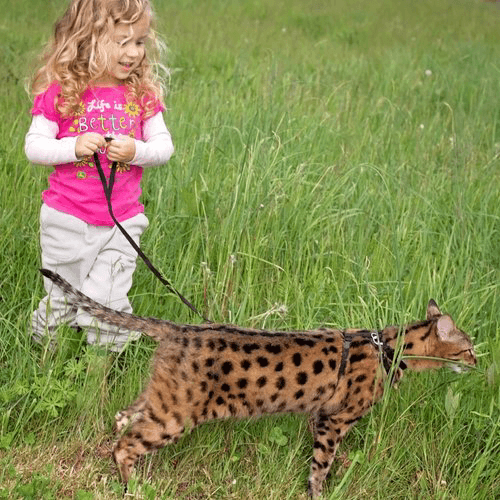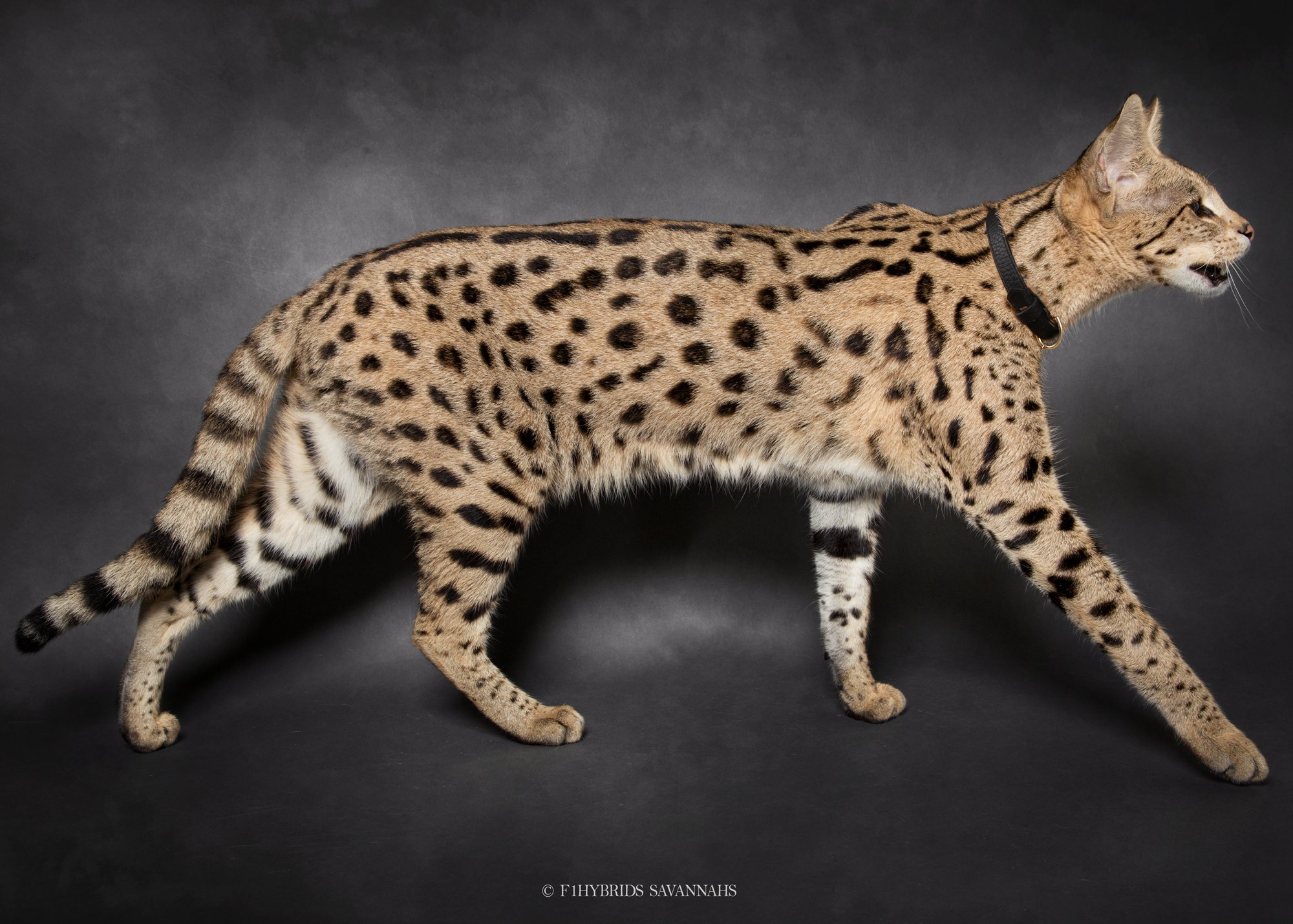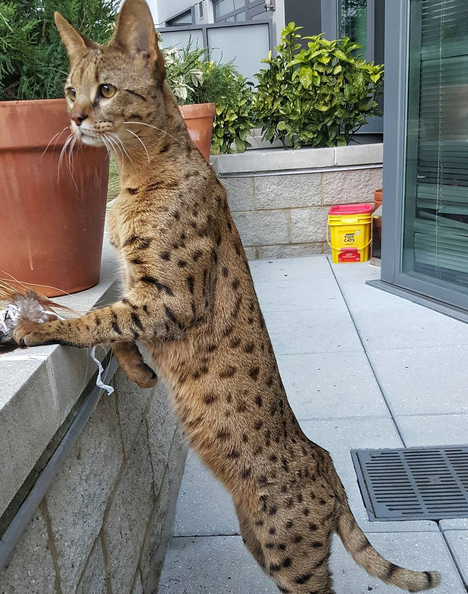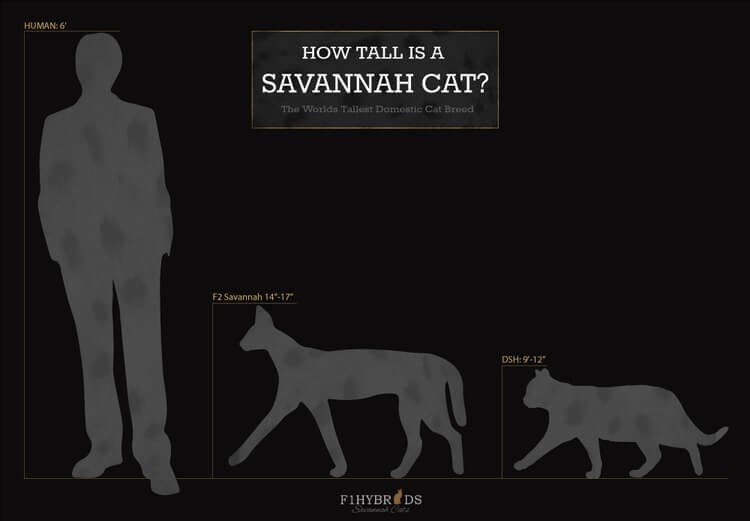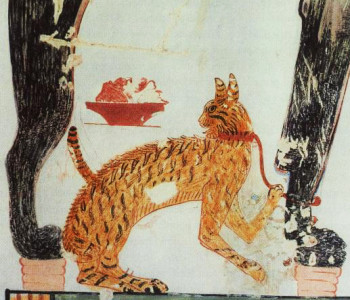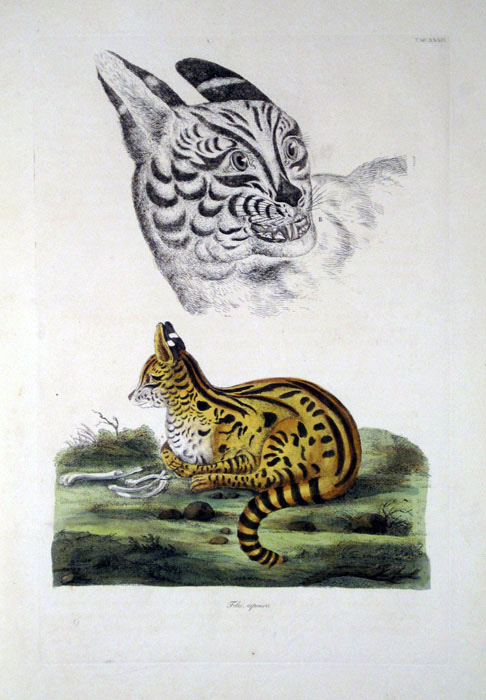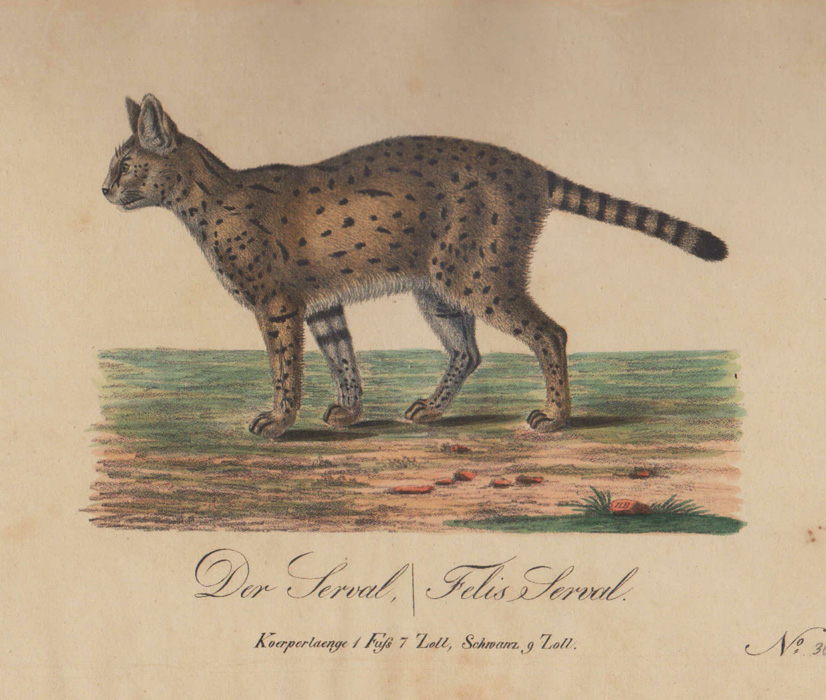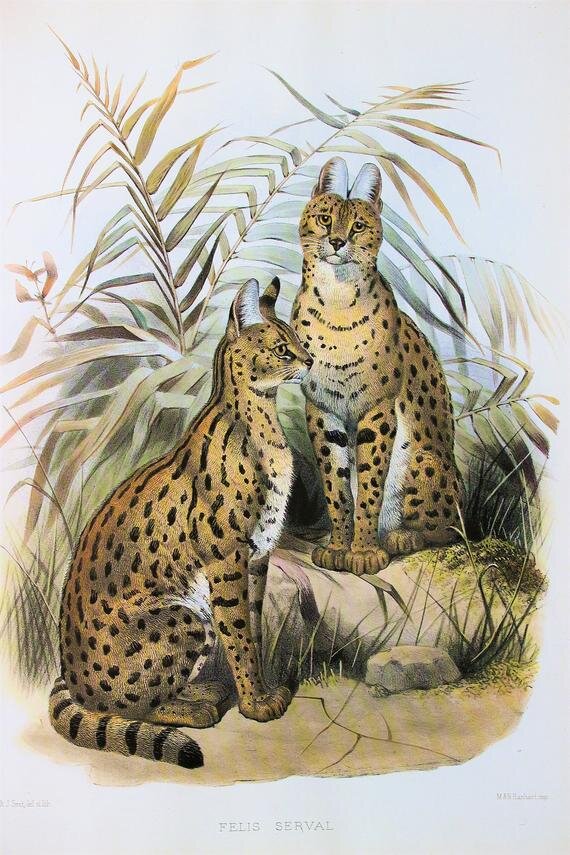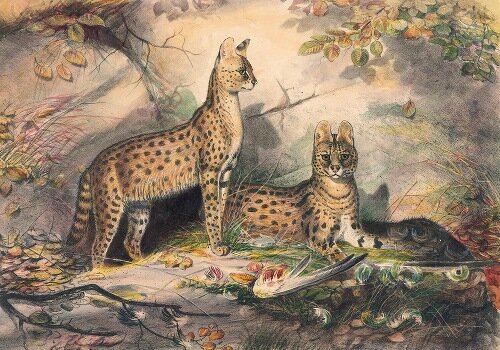Savannah Cats
The World’s Tallest Domestic Cat
Savannah Cat, Produced By F1HYBRIDS
Savannah Cats are a domestic breed descended from the African Serval started in the 1980s. Developed to achieve a wild cheetah-type appearance, expressive eyes, dark tear stains, vibrant coat colors, solid contrasting black spots, huge sonar-like ears, and long legs.
Unique Traits of the Savannah Cat include playing fetch, walking on a leash, giving headbutts, snake hiss, chirping like a bird, very high jumping, and high energy/intelligence.
Scientific name: Felis catus × Leptailurus serval
Lifespan: 12-20 years
Weight: 12-25 pounds
Exercise: High
Hypoallergenic: No
Energy Level is high, and exercise is required for a Savannah Cat. Exercise combined with socialization is an extremely important part of a kitten's training into adulthood. Exposure to friendly atmospheres with positive reinforcement works best. You should expect only what you put into this type of cat, lazy owners not advised.
Temperament for the Savannah Cat is outstanding when properly raised, some would say the feline version of a dog. Ideal companions for owners who want to avoid extra canine requirements but want an active engaging pet. They actively seek social interaction. They are given to pouting if left out. Remaining kitten-like through life. Profoundly loyal to immediate family members.
F1 Savannah Cat © F1Hybrids Savannah Cats
Lifespan average of Savannah cats is 12-20 years. Expected lifespan depending on heritage from domestic cat and Serval Cat. Domestic cats can live up to 15 years, typically 10-12 years whereas a Serval Cat live up to 20 years. It is proven that Savannah Cats who eat a properly balanced raw meat mixture will have a better chance at a longer life.
Famous Owners of Savannah Cats (produced by breeders over the years) include the King of Morocco, Hollywood Movie Director Doug Freeman, Justin Beaver.
High intelligence combined with being naturally curious gets them into mischief. Due to high intelligence, curiosity, and high energy needs, they are best suited to active dedicated owners.
Strangers may be questioned by the Savannah Cat but they warm up as they are very curious with a desire to interact. Making excellent companions for dedicated owners that are loyal, intelligent, and eager to be involved. Demonstrated by the ability to learn simple to complex commands.
The foundation of the breed included various cat breeds, utilized to gather desirable traits to achieve the Savannah Cat. When the Savannah Cat moved to Championship statues with TICA all outcrossing was stopped.
Foundation Cat Breeds Of The Savannah Cat
Generations represent the number of pairings removed from the Serval Cat. Generations are important to breeders because stud males are not fertile until 10% or less exotic heritage. This means you can not get kittens from an F1 Savannah X F1 Savannah. F1-F4 males are sterile (See hybrid infertility below). Out-crossing to different breeds is not permissible. The breed moved to championship status in 2012, meaning that “Purebred Savannah Cats” can be shown at TICA cat shows.
Purebred Savannah Cats have three (3) or more consecutive generations of Savannah to Savannah heritage. Purebred Savannahs (SBT) have the most advanced breed status and are able to be shown at TICA cat shows. They are the key to locking quality Serval traits in a breeding line. They are similar in behavior to the average domestic cat however they are high-energy. They will have SBT classification on their TICA registration.
Hybrid Infertility is when a hybrid cross can not reproduce due to genetics. Joyce Sroufe, the founder of the breed, retained all generations attempting to get fertile males. She was unsuccessful until five generations removed from the African Serval Cat. Commonly F1 & F2 females are sterile.
Breed Standard calls for all traits to mimic those of its ancestor the African Serval. The goal of the breed is to obtain a well-rounded temperament yet wild-looking breed that makes a suitable alternative to an exotic pet. Poorly developed bloodlines can be mistaken for Bengal Cats, which have an opposite body structure to the Savannah.
Ears should resemble those of the African Serval Cat. African Serval Cats have the largest ears of all felines, and the largest ears in relation to the head size of any cat. As a result, the Savannah Cat's ears are remarkably large and high on the head. The ears are wide with a deep base. The ears should be upright and have rounded tips.
Ocilli Ear Markings behind their ears are used to scare off predators (inherited from the Serval Cat). Ocelli marks can be found throughout nature, Such as the wings of butterflies, ears of most wild cats, and even tabby cats. Serval Cats have an "ocilli" marking behind the ears which are high-contrast marks that are thought to scare off predators by mimicking the eyes of the predators' own enemies. Savannah Cats often a muted ocille mark with less contrast. Lacking the high contrast of black with white color combination. It is considered desirable to have black with white but not a fault to have lesser contrasting colors (black with brown, brown with brown).
Pattern is solid dark spots that can be round or oval flowing across the body and should not be connected. A series of parallel stripes, from the back of the head to just over the shoulder blades fan out slightly over the back. Smaller spots may be found on the legs and feet, as well as on the face. The coat is dense short hair that can be coarse or soft in texture.
Head should be broad, modified wedge with rounded contuers. The head should be longer than it is wide. The anterior view of the face should present a distinct and symmetric triangular shape. The nose is long with a small chin. It is preferred for the head to have the “l l” marking rather than “M” marking, although this is not in the breed standard.
Savannah Cat © F1Hybrids Savannah Cats
Colors of the Savannah Cat are brown, silver, black and smoke. Acceptable colors are those that mimic the African Serval. The most common variation of the African Serval is a buttery gold color with solid jet black spots. Gold is a shade of brown so it is correctly registered as a brown spotted tabby (BST).
Brown Spotted Tabby = Aguoti Cat (A-)
Silver Spotted Tabby = Aguoti Cat (A-) + Inhibitor gene
Black = Non-Aguoti Cat (AA)
Smoke = Non-Aguoti Cat (AA) + Inhibitor gene
Eyes should be medium-sized and set underneath a slightly hooded brow. The top of the eye resembles a boomerang, which is set at an exact angle so that the corner of the eye slopes down the line of the nose. The bottom half of the eye has an almond shape.
The eyes are moderately deep set, low on the forehead, and are consistent with facial symmetry. Tear stain markings are present along and between the eyes and the nose. All eye colors are allowed and are independent of coat color.
Savannah Cat on a walk © F1Hybrids
Leash training often is tried with success on Savannah Cats. Leash training on a harness is possible with Savannah Cats. Walking on a leash with a harness does take practice and patience.
Chirping is often heard in early generations of Savannah Cats. They sound like baby birds. This is only done when they are very excited, happy, or calling to find their “loved ones”.
Allergies still happen around Savannah Cats even though they are short-haired cat breed. No cat breed is truly hypoallergenic. Savannah Cats are NOT hypoallergenic.. No scientific data supports hypoallergenic cat breeds. Most allergy sufferers are allergic to the protein found in cat saliva, not hair, so they are allergic to all felines.
Savannah Cat © F1Hybrids Savannah Cats
Price is based on confirmation to the breed standard, temperament, demand, and scarcity. When a Savannah Cat has traits in line with the breed standard they are of higher value as a pet or breeder.
Savannah Cat © F1Hybrids Savannah Cats
Breeders are obligated as TICA registered members to provide registration papers, and age-appropriate vaccinations and retain kittens until the age of 10-14 weeks, which is costly.
Females often have small litters. Unlike dogs, the Savannah Cat’s heat cycles are completely unpredictable. Some cats do not cycle every year, especially true of F1 Savannahs. It is extremely common for F1s to only have 1 or 2 kittens. Some cats can lose some or all fertility as they age. Some Savannah stud male only sires a few litters.
The closer to the exotic linage results in a larger size but extremely small litters and higher cost. The further away from the Serval the litters get larger in size, the size gets smaller and the cost decreases per kitten. Few F1 Savannah Kittens are born around the world every year.
| Generation | Litter Size | Price | Fetility Rate | Difficulty |
|---|---|---|---|---|
| F1 Savannah Cat | 1-3 | $16,000+ | Very Low | Extremely Difficult |
| F2 Savannah Cat | 1-4 | $6,000 - $10,000 |
Low | Difficult |
| F3 Savannah Cat | 2-4 | $3,000 - $5,000 | Moderate | Moderate |
| Purebred Savannah Cat | 3-5 | $1,500+ | Average | Average |
Buyers can wait years for a breeder to produce an F1 Savannah Kitten. Females are almost exclusively placed or retained for breeding, infertility of these females often prevents them from producing. Less than 50% of all F1 & F2 females kept for breeding ever reproduce. Then when you compare generations the expected size and size of litter affect the overall price.
Nutrition requirements are the same as the average domestic cat. Almost all cat foods from a grocery store are not properly balanced for any type of cat. Feeding cheap filler-filled foods will lead to bones being brittle bones that can break easily.
These cheap foods have been linked to diarrhea, weight loss, and even cancer. Savannah Cats grow at a fast rate so proper nutrition is vital. Savannah Cats do not require a raw meat diet however a raw meat diet is the most nutritional diet available if properly prepared. Work with your veterinarian and breeder to determine the frequency of meals.
Size Comparison - Domestic Cat Vs Savannah Cats
Size of Savannah Cats is often exaggerated because they are taller, thinner framed and longer bodied than the most domestic cats. This taller body type gives the illusion of more weight.
Weight depends on individual bloodline. Weight can range between 12-25 pounds.
Legal requirements have to be considered in some USA states. Savannah Cats sometimes get caught in ban bills due to loose wording meant to prevent the ownership of larger exotic pets.
Often these ban bills get corrected over time and proper education is provided to officials.
The following states have restrictions: Alaska, Delaware, Georgia, Idaho, Iowa, New York, Nebraska, New Hampshire, Massachusetts, Rode Island, Texas, Vermont, and Hawaii. Review your state laws pertaining to hybrid animals on HybridLaw.com
Fun Fact!
Most Savannah Cats have less than 10% Serval Cat genetics (According to TICA registration numbers).
Ancestor of the Savannah Cat is the African Serval Cat which has been actively bred in captivity since the 1920s. This wild cat is native to Africa. It is rare in North Africa and the Sahel, but widespread in sub-Saharan countries except rainforest regions.
They are vulnerable to hyenas and wild dogs. In the wild, they will seek cover to escape the view of a predator. If a predator is too close they will flee in long leaps, changing direction frequently and with their tail raised. The African Serval Cat is able to purr, has a high-pitched chirp, hiss, cackle, growl, grunt, and meow.
Compared to a Savannah Cat the African Serval Cat will cost double daily to maintain, they do not tolerate strangers, they will only eat raw meat and once fully grown they will not use a litter box.
Desirable traits and exotic looks are why the most owner of African Serval Cat convert to owning a Savannah Cat.
We have compiled a rare look at historical depictions of Serval Cats dating back to the 1400's, see below pictures.
Savannah Cat Right For You?
It may comes as a surprise that the majority of Savannah Cat Owners don't purchase for exotic looks. Rather they seek a pet with a combination of traits that the Savannah Cat has to offer.
Savannah Cat © F1Hybrids Savannah Cats
Savannah Cats are similar to owning a “working dog breed”, they are high energy, highly intelligent (problem solvers), curious, highly trainable and can be strong-willed.
A “working dog breed” is a breed of dog that is not merely a pet but was specifically bred to perform tasks to assist its human companions. Working dogs are typically high-energy, highly intelligent (problem solvers), curious, highly trainable, and can be strong-willed.
These traits make “working dogs” capable of performing the tasks humans chose them to perform. This ingrained nature requires them to need a dedicated owner who can provide a dependable home life with exercise, mental stimulation, training, socialization, and of course positive human interaction.
These are all things any owner should provide any type of dog. Any noted “bad” behaviors in Savannah Cats are behaviors found throughout all breeds of cats. Typically due to poor human management due to not understanding basic cat behavior. Unfortunately, it is common for cat owners, regardless of the breed, to blame the cat and not themselves. As Cesar Milan the “Dog Whisper says; “I rehabilitate dogs; I train people”. The exact same can be said for cats.
Should you own a Savannah Cat? Key points about temperament.
If you are seeking the following traits then a Savannah Cat might be right for your home; High Energy Level, Not Lap Cats (They Will Be Next To You), High Intelligence, Use a Litter-Box, Rambunctious, Affectionate, Expressive, Curious and Outgoing.
Savannah Kittens For Sale
I have kittens available to be reserved!

